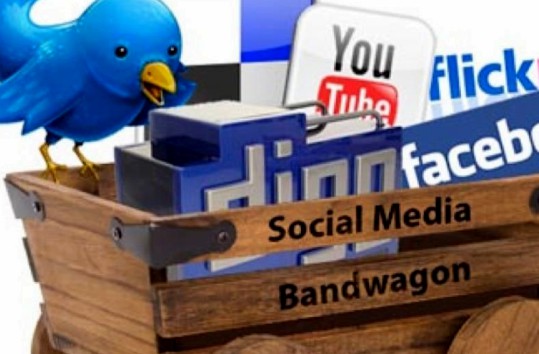Our Latest Blogs
Our Solutions News Blog was envisioned to gather and share information from the very best to help you and your business to become more effective.
Our Solutions News Blog was envisioned to gather and share information from the very best to help you and your business to become more effective.

As a savvy inbound marketer, you already know that social media is a must-have in your marketing strategy. You’ve spent time looking at what channels work best for your company, creating the best content you can for those outlets, and aligning the social media goals to the business' bottom line. You live and breathe social media every day on the job.
But that's not true for everyone else in your organization. Not everyone is sold on the importance of social media -- never mind manage their own presence. What about that VP down the hall with tons of killer industry knowledge or that executive you know who spends hours talking to customers? These executives may not be active in social media just yet, but they should be.
This is where you come in. If you think there are executives in your company who could add credibility to what you’re already doing, it’s time to get them on board.
Why Should Your C-Suite Be in Social Media?
Often, executives may feel like there's not much for them to do in social media. They hired a social media manager to watch over the company's presence, so why would they need to be in social media as well? Though some executives at your company may have already made up their minds about their social media participation (or lack thereof), it's incredibly important to have them in social media.
Having a presence in social media gives executives the opportunity to stay relevant with industry trends, engage with your prospects and customers, and show that they stand by and believe in your brand. By not listening and participating in social media, executives are missing out on numerous opportunities to improve your business. And ultimately, growing your business is every executive's objective.
How to Get Your Executive Team in Social Media
Getting executives in social media isn't as simple as signing up for a Twitter handle and asking them to tweet. Instead, you've got to be strategic if you want to get on board. By following these five steps, you can develop a socially savvy executive team.
1) Pick the right executives for the job.
Not every executive is ready to dive headfirst into social media -- and that's okay. Instead of proclaiming that all executives must start tweeting immediately, start off with a select few that you know would be successful in social media if you were to show them the ropes. Think about who would be a good advocate for your brand and have the potential to be a thought leader. Also, see how active they are in social media already. You may want to check out LinkedIn first to see who’s active already, since executives prefer LinkedIn to any other social site. This will give you a good indication of who to approach about helping build your brand in social media.
After you understand who’s been up to what, it’s time to think about your approach. Asking an executive who isn’t that familiar with Twitter or Facebook to jump right in isn’t going to work. First, they need to get an understanding of what's happening on social media for your brand.
2) Show them why they should care.
While 90% of business executives say that social media tools are important for brand awareness and company reputation, that doesn’t mean they're personally doing anything about it. This might be because they think they don’t have anything to add, they don’t know what to say, or they aren’t really in the loop with the happenings in social media at your company.
Here's your golden opportunity to show off what your company is doing and form a plan for what the executives could be doing, too. Invite the executives you identified in step one to a meeting to give them an overview of how your company uses social media and how it’s affecting the rest of the business.
When you meet, bring numbers that those in the room care about. If your goal is to get a seasoned VP of Sales involved in social media, you’ll probably want to show them how many leads social media generates for your company a month. For a VP of Sales, leads = perked ears. Figure out what gets each executive excited about being in social media, and be sure to highlight it for them.
3) Let the benefits get personal.
This is probably where to expect some pushback. I can hear it now: “But why do I have to be involved? Didn't we hire a social media manager to handle this?"
You want these questions. You’re ready for these questions. Now that you’ve shown the executives what the company is doing, you can show them how their social presence fits into the overall social media team effort.
You can prepare for these questions by giving them concrete reasons for participation: Based on a recent social media survey by BRANDfog, executive social media engagement creates brand transparency (score!). It makes a brand seem more honest and trustworthy (win!). And, it makes executives better communicators overall (bonus!). Make sure they understand exactly what they will get out of this new experience -- you'll be much more likely to get them on board.
4) Set them up for success.
So they're up for the challenge -- now it’s time for them to get down to business. If they’re hesitant to jump in headfirst, offer to get them all set up and give them a demo of what to do. At this point, you’ll know how much handholding is necessary for each executive -- use your judgment. There’s a balance between relying solely on executives' intuition and independence and losing them in the noisy crowd.
If they need help getting started, give them a couple of ideas of what to do. Maybe you come to the table with some sample content they could share or people to follow. Suggest some goals for them to aim for each week (X tweets, X Facebook posts, etc.). If you're a HubSpot customer, maybe set up a dedicated email alert in your Social Inbox. However you decide to start, make sure the task is fairly easy. The beginning is always the hardest and you don't want your executive team to be discouraged right off the bat.
5) Maintain momentum by checking in periodically.
At this stage, you’ve done some serious work getting your executives up and running. You’ve explained your company’s social strategy, the benefits of executive involvement, and the steps to get involved on those channels. You’ve given them all the tools they need to become socially savvy.
To keep up momentum, schedule regular check-ups with the executives. Show them some results from their social media efforts and identify what’s working and what’s not. Real-life examples and metrics are a must here, especially when you have data available to track conversions of current leads and customers through social media.
It may be a slow start, but every step is a step forward. Make future plans to keep the conversation going. One possible idea is to schedule a monthly get-together to talk about social media news and how they could integrate that into what they’re doing. Managing a social media presence isn't a one-and-done effort -- it needs constant evaluation and planning to maintain and grow.
Eventually, you’ll find the rhythm that works best for your company. Creating a socially savvy executive team doesn’t happen overnight. But with the right approach, you may start to change the way your executive team thinks about social media. And who knows -- maybe one day, your CEO will want to take over Twitter for the day.
Source: HubSpot

Natural Resources Canada (NRCan) is undertaking an R-2000 Net Zero Energy pilot (the Pilot) to recognize builders and homes reaching net zero energy performance in Canada, and to pilot the next generation of NRCan's 2014 R-2000 Standard and EnerGuide Rating System in net zero energy applications.
Drawing on NRCan's systems and infrastructure - including its certified energy advisors certification process and quality assurance protocols - will provide recognized metrics, objectivity, standardization and credibility to this emerging space.
In addition to doing a field trial of the next generation standards, NRCan will use the pilot to examine the best means for seamlessly incorporating net zero energy offerings into its suite of standards on a permanent basis.
NRCan will also use this opportunity to explore possibilities surrounding net zero energy ready homes.
Design Seminars and Request for Proposals
The Pilot will be implemented in several phases over the next two years.
The next step in the Pilot process is a design seminar on May 15, 2013that will present NRCan research that demonstrates that an R-2000 home can achieve net zero energy home performance using commodity technologies and methods, as well as provide a cost ball-park, guidelines and starting point for those interested. The design seminar will take place via webinar.
A request for proposals (RFP) for participation in the Pilot will be issued following the design seminar in May. It will be open to any builders from across Canada that are interested in piloting the standard to build and certify their houses to this ultimate level of energy performance.
The RFP is designed to evaluate the merit of the applications. It is expected that a maximum of 10 applicants will move through the RFP stage. These applicants will then need to provide detailed house designs and modelling results to complete the design stage.
Where necessary, NRCan will work with participants to develop modelling workarounds should the HOT2000 simulation software not contain a model for proposed products or equipment.
The RFP will close on mid-late June, followed by an RFP evaluation. The Design stage will last from early August to the end of October. Finally, construction and labeling will take place from November 2013 to November 2014.
An ERS "Efficient Living Assessment" will be completed on each house to obtain as-operated energy performance after occupants have moved in. Lastly, post-program analysis will be undertaken to allow NRCan to formalize within its suite of standards "R-2000 Net Zero Energy" recognition, and potentially "R-2000 Net Zero Energy Ready". It will also provide valuable lessons-learned to interested builders for the future.
Background information about the Pilot
NRCan has committed to using a Standards Council of Canada based process to develop the next generation standards for R-2000, ENERGY STAR for New Homes and the EnerGuide Rating System (ERS) to ensure open and transparent processes and input from stakeholders.
Over 500 stakeholders have participated in these processes over the past three years. NRCan is now looking to test those standards with respect to net zero energy homes.
The R-2000 Standard will form the basis for the pilot. Houses labelled under the Pilot must meet the requirement of the draft2014 R-2000 Standardand obtain a rating of zero gigajoules using the new ERS scale.
The Pilot will also focus on off-the-shelf technology (i.e. engineered pre-packaged systems rated to an internationally-recognized performance standard) in order to advance the commoditization of net zero energy homes in Canada.
Why use R-2000 and ERS as the basis?
R-2000 is an established national standard with the training, certification, house-testing, inspections and overall quality assurance that are an essential part to ensuring the integrity of net zero energy housing/
The minimum envelope requirements of the draft2014 R-2000Standardwill be applied in order to ensure the building envelope and other long-term elements are well-addressed before renewable energy technologies are used to offset conventional energy use.
The R-2000 builder community has long been the group of experts advancing energy innovation in home building, and this Pilot, along with the next generation standards, will help to reinvigorate and bring together again this community of leaders, coalescing the R-2000 and Net Zero communities.
Using the next generation ERS rating scale offers an ideal opportunity for participants to use and feed into the next generation ERS process to ensure it addresses any outstanding issues that relate to net zero energy homes.
Benefits of participating
Builders will have a first to market claim on this new Government of Canada certified level of recognition from NRCan. They will also play a key role in setting the requirements for labelling Net Zero Energy homes in Canada. NRCan will offer technical support and promotion as an in-kind contribution to each participant.
Pilot participants will also benefit from collaborating with leading experts to gain insight into design of homes using available, high performance building envelope products, technologies, and techniques that can be used to achieve net zero energy performance.
Participants who are successful through the request for proposals process will also have access to modeling support from NRCan simulation experts for technologies that cannot be modelled using HOT2000.
This pilot will give participants an opportunity to demonstrate industry leadership with first-to-market, NRCan-recognized net zero energy homes built and certified under the quality assurance of R-2000. NRCan will also work with the pilot proponents to raise awareness about the pilot and its participants.
Source: Globe-Net

Guy Kawasaki is a special advisor to the Motorola business unit of Google. He is also the author of APE, What the Plus!, Enchantment, and nine other books. HubSpot invited Guy to reveal the secrets behind his incredibly active and popular social media profiles that enable him to reach millions each day.
Many people ask me how I manage my social media accounts (and others make stuff up rather than figure out what I do). Here are the gory, inside-story details of what I do. Perhaps you may find some of my methods useful to help you get the most out of social media, too.
Twitter
On Twitter, I'm @GuyKawasaki. My Twitter practices defy the recommendations of social media "schmexperts" (schmuck + experts) to manually post a limited number of tweets and not use automation, repetition, contributors, and ghostwriters.
I have never been on the Twitter Suggested User List, and I have more than 1.2 million followers. I attribute this success to providing a lot of interesting links that people retweet. These retweets expose me to many people who then follow me. There are five (yes, five -- count 'em) sources that feed my Twitter account:
1) HolyKaw
I co-founded a website called Alltop. Half of it is an aggregation of 30,000 RSS feeds organized into 1,500 topics ranging from adoption to zoology. The other half is a website called HolyKaw.
HolyKaw provides a continuous flow of interesting and diverse stories that should elicit the response, “Holy cow!” (Holycow.com was taken but since my name is pronounced “Cow-asaki,” I figured that HolyKaw would work.)
The posts on HolyKaw are short summations of stories, a picture or video to illustrate the story, and a link to the source. Approximately twenty people/organizations have contributor-level access to HolyKaw.
We pay several as editors -- they are not “interns” in the sense of unpaid students. Organizations such as Futurity and National Geographic also have contributor-level access because they consistently post great stories.
The headline of a HolyKaw post -- for example, “Compilation of stories about introverts, outsiders, and loners” -- automatically generates tweets that go out through a custom app called GRATE, for “Guy’s Repeating Automated Tweet Engine." These slightly modified tweets appear four times, eight hours apart.
The reason for repeated tweets is to maximize traffic and therefore advertising sales. I’ve found that each tweet gets approximately the same amount of clickthroughs. Why get 600 page views when you can get 2,400? Like CNN, ESPN, and NPR, we provide content repeatedly because people live in different time zones and have different social media habits.
2) Repurposed Google+ Posts
Three other people also post to HolyKaw via Google+: Peg Fitzpatrick, Trey Ratcliff, and me. (I explain this in the Google+ section below.)
3) Repurposed Facebook.com Posts
Peg Fitzpatrick manages the Facebook.com/guysco brand page. When she posts stories there, they automatically appear as tweets.
4) My Comments and Responses
I use Tweetdeck to respond to @-mentions of @Guykawasaki, as well as to direct messages. If you see a response tweet, it is always me -- never anyone else.
5) Promotional Tweets
Finally, if you see a tweet that is promoting my books, appearances, or investments, it’s almost always one that I posted with Tweetdeck or that Peg Fitzpatrick has scheduled using HootSuite.
Google+
On Google+, I'm GuyKawasaki, and Google+ is the core of my social media existence. It is the Macintosh of social media: better, used by fewer people, and often condemned by the experts. Unlike other social media profiles I own, no one else ever posts, responds, or comments on Google+ as me.
My orientation toward Google+ (and social media in general) is what I call the NPR Model. My role is to curate good stories that entertain, enlighten, and inspire people 365 days a year. My goal is to earn the right to promote my books, companies, or causes to them just as NPR earns the right to run fundraising telethons from time to time.
My posts range from first-person accounts of being a black tourist in China, what happened to Allen Iverson after his NBA career, and gifts from Air New Zealand. I use five primary resources to find stories to post:
1) My Alltop Account
This is a custom compilation of the RSS feeds of websites such as In Focus, The Big Picture, YouTube, and NPR that are mother lodes of great content. This is my one-stop shopping cart for content.
2) HolyKaw
Yes, I post what my contributors post as me (i.e. under my name) because the HolyKaw contributors are often better at being me than me. Wrap your mind around that.
3) What’s Hot Feed of Google+
Think of this as crowdsourced story leads. The beauty of this feed is that you know that people have already judged the stories as good, though it tends to be heavy on Android news and inspirational quotations.
4) Most Popular Stories
When I’m checking out stories from the first two sources, I look at the “Most Emailed” and “Most Popular” listings on the right side of most websites. These often yield great material. I’ve also compiled a collection of most emailed and most popular feeds at Most-Popular.alltop to make this even easier for you.
5) Pointers From Various Friends and Family
Many people know that I’m on the hunt for good content, so they send me leads. These are almost always good enough to post.
Some of my Google+ posts pass the “holy cow!” test, and there is a plug-in to publish Google+ posts to a WordPress blog. This means I can cherry pick my Google+ posts for HolyKaw. (Look for the hashtag “HolyKaw” to see which will appear in HolyKaw and later Twitter.)
Peg Fitzpatrick, Trey Ratcliff, and I use this method to select some of their Google+ posts for inclusion in HolyKaw. They do this to gain additional exposure since these posts are tweeted to my 1.2 million Twitter followers four times eight hours apart through the HolyKaw GRATE machine.
Three Google+ Power Tips
I adore Google+, so let me provide these power tips for using the service:
1) Find anytime, but post when you’re cogent.
I often get up in the middle of the night and check Alltop and the Google+ What’s Hot feed on my Nexus 7. When I find something good, I share it to a Google+ private community with only one member: me. When I wake up in the morning, I go to this community to see what stories I found in a less cogent condition and write up a post.
2) Schedule Google+ posts.
There are multiple ways to schedule Twitter, Facebook, LinkedIn, and Pinterest posts using various tools. However, Google+ makes it harder than those services. There are two ways to do this, however. First, there’s Do Share, a Chrome extension. Second, if you have a HootSuite enterprise account, you can schedule to a Google+ Business Page (as opposed to a personal profile). Since my Google+ focus is on my personal profile, I don't use the HootSuite method.
3) Get rid of trolls.
Be a hard-ass: Get rid of people who irritate you. Think of your Google+ posts as your swimming pool. If people pee in it, throw them out. There are some people you need to get out of your social media life. A Chrome extension called Nuke Comments is a lovely solution because it enables you to delete a comment, block the person, and report him/her with one click.
I have two personas on Facebook: Facebook.com/guy and Facebook.com/guysco. The first is a personal profile, and the second is a brand page. I operate them differently.
First, a virtual assistant monitors my Google+ account and manually adds most of my Google+ posts to Facebook.com/guy using Buffer. (Disclosure: I advise Buffer.)
There are plugins that can automatically publish Google+ posts to Facebook. However, every Google+ post is not appropriate for Facebook, and there’s no way for me to tag the ones that are appropriate. Thus, a human has to make the decision, download the photo or YouTube embed link, make minor edits such as removing the “+” in Google+ +mentions, and post to Facebook.
I monitor comments at Facebook.com/guy and respond to them as much as time permits. My virtual assistant never acts as me, so either I answer or there is no response at all.
Second, for Facebook.com/guysco, Peg Fitzpatrick, whom I mentioned earlier, makes all the posts to this page, and these stories automatically become tweets. This Facebook Page is a branding effort for “Guy’s companies,” which are primarily my books.
On LinkedIn, I am Guy Kawasaki. The virtual assistant who takes my Google+ posts and publishes them to Facebook uses the same process for LinkedIn using Buffer. One of the cool things about Buffer is that you can post to Facebook and LinkedIn at the same time, so this is easy.
There are seldom comments on my LinkedIn posts, so I seldom visit my posts to respond -- of course, this may be a self-fulfilling process. But I have to draw the line somewhere, or I’ll never play hockey during the day, which is a key component of my happiness.
On Pinterest, I'm Guykawasaki, but Peg Fitzpatrick manages my Pinterest presence. There are two reasons: First, I don’t have enough time to do a good job with more than three services (my priority, in order, is Google+, then Twitter, then Facebook).
Second, I don’t have Peg’s magic sauce to manage Pinterest as well as the Pinterest community deserves. Part of doing social media well is knowing what you don’t know and what you can’t do well, and then finding someone who does.
Conclusion
Don’t get the impression that there is a huge team of people doing what I described above. The total of all resources, excluding my own activities, is approximately one full-time equivalent. In addition, I spend three to four hours per day creating my own posts and commenting and responding.
To summarize, here’s quick wrap-up to review my social media methods:
Twitter: Mostly generated from the headlines of HolyKaw stories, four times, eight hours apart; contributions via Google+ and Facebook; and manual promotional tweets.
Google+: Me only. Think of me as the Mike Rowe of Google+ -- I'm willing to do the "dirty jobs."
Pinterest: Peg Fitzpatrick acting as me.
Facebook and LinkedIn: Virtual assistant reposting some of my Google+ posts.
Again, no one responds as me (for better or worse, as I've sometimes learned) on social media, though many different people may be behind a post.
This is how I manage my social media presence as of May 2013. I hope there are techniques here that you can use. Stay tuned, because my procedures are ever-changing.
Source: HubSpot

The first home in Canada qualified under the new ENERGY STAR® for New Homes (ESNH) Standard was unveiled last week in Guelph Ontario.
The custom home, built by Sloot Construction Ltd., is located in Phase II of the Hale's Manor community in Guelph.
Attendees at the unveiling were provided with a pictorial overview of the energy-efficient features of the home and an airtightness test demonstration, one of the stringent criteria for qualification under the ESNH Standard that also requires the inclusion of energy-saving features such as:
The ENERGY STAR® for New Homes initiative was developed by Natural Resources Canada to help the public easily identify homes that are approximately 20 per cent more energy efficient than those built to minimum building codes.
To receive the ENERGY STAR® qualified label, homes are inspected to ensure they meet the technical requirements for energy efficiency developed by the Government of Canada. Each ENERGY STAR® qualified home is third-party verified by Certified Energy Evaluators, and labelled by EnerQuality, a licensed Service Organization.
The ENERGY STAR® name and symbol are registered trademarks of the United States Environmental Protection Agency (US EPA) and are administered and promoted in Canada by Natural Resources Canada.
"The home building industry, led by innovators like Sloot Construction, continues to demonstrate its capacity to aim higher and do better," said EnerQuality's Corey McBurney. "The new national standard raises the bar for better-built homes, and sets a benchmark that is readily achievable by both custom and production residential builders."
"In five years, this Standard will be the 'new normal', as it will inform the Ontario Building Code minimum requirements," McBurney continued.
Building codes around the world are moving quickly toward low-carbon and carbon neutral performance standards. The National Energy Code for Buildings in Canada recently published the first generation of outcome-based codes for Canada, which is in the process of being adopted by several provinces nationwide.
Retrofitting existing homes and buildings for energy efficiency is a largely latent market which has been highlighted by many policy makers as a primary means by which to create jobs while reducing community energy consumption and greenhouse gas emissions.
GLOBE Advisors is currently working on a project in British Columbia on behalf of utilities and the provincial government to develop a strategy for further developing the home energy performance industry in that province - a strategy that will focus largely on increasing consumer demand for retrofit activities and catalyzing industry support for related activities and services.
Municipal building codes (where relevant) are also raising the bar for energy performance of the building stock.
In Vancouver for example, the Greenest City Action Plan has established a 2020 goal for all new buildings to be carbon neutral and the existing building stock as a whole is to be 20 per cent more energy efficient. Achieving this goal requires a shift to performance-based codes and to a building design approach which focuses on a building's envelope first.
Source: Globe-Net

I was an early proponent of QR Codes, but now I have to admit that they are history. Invisible ink and augmented-reality apps are replacing the clunky codes. The new technology is superior in that you don't have to take a picture of the code, which then records your contact information and sends you to a website, video or document, or sends you a text message giving a web address. With the new apps, you just run your smartphone over the content and get the enhanced features immediately.
Here's a sampling of the new technologies that will surely supplant QR Codes, permanently.
As Springwise reports, the Japanese newspaper Tokyo Shimbu has launched the AR News app, which enables kids to scan specially marked articles with smartphones to reveal more kid-friendly versions of the stories.
The app was developed by Dentsu, which was challenged to make newspapers appealing to younger readers. Articles suitable for children are printed with blue borders. Using AR News app, readers who place tablets or smartphones over those articles will see a simplified Japanese alphabet for those still learning to read, along with animated characters and graphics, pop-up headlines and explanations that make the topics easier for kids to understand.
Blippar is a mobile app that lets users pull information, entertainment, offers and augmented-reality 3D experiences from markers placed on newspapers, magazines, products and posters. No clicks, no delays, no codes, says Crunchbase: just instant gratification.
Another new technology, Touchcode, is an invisible electronic code printed on paper, cardboard, film or labels. When you touch your smartphone or tablet to it, tickets sing, toys come to life, or you can confirm the authenticity of a brand, just to give a few examples. Items imprinted with Touchcode's invisible ink look no different from standard print products, until you touch them with your smartphone.
The QR codes did have some brilliant and successful applications, like the mobile-code campaign for an independent music store in Hong Kong that sold music by allowing users to listen to and buy the tunes of 14 bands, half of which sold out their inventory. But more often, the codes were deployed poorly in spots where they couldn't be scanned, like billboards, or -- perhaps lamest ever -- on license plates. Some QR Codes require a proprietary scanner good only for that code, which few people are likely to want to download. And, while many people still have no idea what a QR Code is or how to use one, instructions rarely have been included.
What are the lessons of QR for brands using the new technologies?
It will be fascinating to see whether these new technologies are used both creatively and effectively. The potential is vast. Hopefully agencies won't blow it this time around.
Author & Source: B.L. Ochman / AdAge digital

It’s 7:54 on a frigid January morning in San Francisco. You’re waiting outside the Moscone Center, in a queue of several thousand people, many of whom have been camping out in the cold for over 12 hours. The security detail for this event rivals the Democratic National Convention. Another hour passes before you’re comfortably seated in a giant auditorium that’s crackling with anticipation.
Finally, at 9:43 a.m., the moment you’ve been waiting for arrives. The thin, soft-spoken man gracing the stage in his signature turtleneck and jeans, clears his throat, takes a sip from his water bottle, then pauses for a full 12 seconds before uttering these words:
"This is a day I've been looking forward to for two and a half years. Every once in a while a revolutionary product comes along that changes everything.”
Such was the scene on January 9, 2007, when Steve Jobs unveiled the iPhone in one of the most captivating product launches in history. Indeed the iPhone was a revolutionary product, but it wasn’t the iPhone that inspired thousands of people to camp out in the cold over night. It was Jobs’ unique presentation style -- which Apple fans referred to as a “Stevenote” -- that helped make this among the most awe-inspiring, memorable keynotes ever delivered.
As Carmine Gallo puts it in his book, The Presentation Secrets of Steve Jobs, Steve “transformed the typical, dull, technical, plodding slideshow into a theatrical event complete with heroes, villains, a supporting cast, and stunning backdrops. People who witness a Steve Jobs presentation for the first time describe it as an extraordinary experience.”
Click Here » to read the full story and learn 7 Lessons From the World's Most Captivating Presenters.
View the SlideShare presentation Here »
Source: SlideShare & HubSpot

The Climate Change and Emissions Management Corporation (CCEMC) is seeking innovative ideas from around the world for a $35 million open innovation challenge that will create new, carbon-based products and markets. The grand challenge is the first ever initiated by an organization in Alberta.
It is expected to identify multiple technologies that could provide significant reductions in greenhouse gas emissions by transforming carbon from a liability into an asset.
The CCEMC is seeking novel solutions for innovative carbon use - bright ideas at any stage of development that are rooted in solid science. Focus areas include, as examples, processes that produce high value goods from greenhouse gas emissions, technologies that fix captured carbon into solid or readily transportable starting materials, high-value materials with high carbon content that could be produced from greenhouse gases and biological processes that capture or consume carbon and convert it into a new viable product, such as the creation of oils from algae.
"We are witnessing how industry-wide open innovation and collaboration can dramatically accelerate and improve environmental performance in the oil sands, a key economic driver for Canada," said Dr. Dan Wicklum, chief executive of Canada's Oil Sands Innovation Alliance (COSIA).
"The Grand Challenge represents a unique opportunity to bring the same kind of leading-edge thinking to the development of new technologies to unlock the potential of Canada's energy economy in an environmentally responsible way."
Submissions are open at www.ccemcgrandchallenge.com and technical solution providers are encouraged to register now to signify their interest.
Read the Full Story Here »
Source: Globe-Net

Download Reports
Overview
GLOBE Advisors undertook six months of research in 2012 examining three high-growth sectors in British Columbia's clean economy - specifically Clean Energy Supply and Storage; Green Building and Energy Efficiency; and Clean Transportation. From this research, GLOBE Advisors published three market reports - one on each of these three key sectors.
These reports build on GLOBE's West Coast Clean Economy study released in March 2012 and provide critical insights on job creation and investment promotion opportunities in British Columbia. The job numbers presented in the reports were quantified using updated and proven methodologies that allow for the identification of industries and occupations that are part of these sectors in B.C.
Secondary research and employment estimates for this study were backed up by extensive consultation and outreach activities, including more than 90 in-depth interviews with industry leaders from successful B.C. companies, academic institutions, government agencies, and non-governmental organizations. The interviews were designed to identify current trends, economic development opportunities and challenges, and employment demand and supply issues.
In addition, GLOBE Advisors was involved in organizing a one-day "Green Workforce Development Symposium" alongside the City of Vancouver, the Vancouver Economic Commission, and six public post-secondary institutions in March 2012 that was designed to explore current and potential future employment opportunities and challenges in BC's clean economy.
Source: Globe Advisors

The time has passed when Facebook was a "good idea" for businesses to try. It's now essential to your inbound marketing strategy. Thing is, Facebook keeps changing how to set up Facebook business pages -- both on the large scale with the rollout of Facebook Timeline, and on a smaller scale with new features that are rolling out all the time.
Don't waste another day poking around aimlessly on Facebook, trying to figure out what the heck to do to get your Timeline up and running like a social networking pro. This post will break it down so literally anyone -- novices and experts alike -- can set up their brand's Facebook Timeline 100% correctly. Either follow this step-by-step [video tutorial], or read the full article [here] to get your business on Facebook today.
Source: Hubspot

The latest annual AdReaction study, focusing on consumer opinions and perceptions of advertising, finds that even in this digital-centric climate, U.S. consumers are likely to view offline media ads most favorably -- with TV viewed positively by 49% of respondents, followed by magazine ads (41%), and newspaper ads (40%).
The 2012 study finds the most positive attitudes towards digital ads are for opt-in email ads, which 28% of respondents find very or somewhat favorable. Social media and mobile advertising rank towards the bottom at 13% and 9%, respectively.
Examining changes in attitudes towards advertising formats between 2009 and 2012, the traditional media types with the most positive favorability changes: newspapers (+6) and radio (+6). The only upticks for digital favorability are for mobile (+2) and non-opt-in email (+2). All other forms of digital media lost favorability points with Americans, led by social media (-8), online video (-6) and online search (-5).
The global study was conducted using qualitative/quantitative methodologies across 18 countries, with a total of more than 6,000 interviews. The U.S. subset findings represent quanitative data only.
Sources: Print in the Mix & Millard Brown, AdReaction

The global transition to a low-carbon economy is underway and firms that supply low-carbon goods and services can thrive in this expanding market.
But for Canada to thrive in a low-carbon context, governments need to act now to set the appropriate policy signals so that businesses can position themselves to be competitive and can tap into this market.
These are the conclusions of a new report the National Round Table on the Environment and the Economy (NRT) released today entitled Framing the Future: Embracing the Low-Carbon Economy, billed as the first report to broadly consider how Canada needs to position itself with respect to low-carbon goods and services markets in order to prosper through the global transition to a low-carbon economy.
"A low-carbon economy is no longer a concept of the future. Governments around the world are moving ahead, and a number of jurisdictions already have formal low-carbon growth plans in place," said National Roundtable Interim Chair, Robert Slater.
"While governments need to put in place the conditions that will stimulate innovation, mobilize investment, enhance market access, and foster talent and skills development, private interests need to drive the process, engage with governments, and play a leadership role in developing a vision for Canada's low-carbon future."
The report seeks to quantify the potential low-carbon market opportunities; assess and characterize the risks to Canada in the transition to a low-carbon future, including quantifying the risk of emissions lock-in; and to put forward a framework for governments and the private sector to work collectively to ensure future prosperity in a carbon-constrained world.
Planning for low-carbon growth can also help navigate any trade, market access and emissions lock-in risks during the process of reducing the emissions intensity of our economy.
The report says the global market for low carbon goods and services could grow from $339 billion (2010) to between $3.9 and $8.3 trillion per year by 2050. If Canada were to retain its current average share of the global economy for these sectors in 2050, domestic low carbon production would reach between $70 and $149 billion per year.
Sending the right policy signals is a pre-requisite for broad low-carbon growth and to help reduce the economic risks associated with accessing and trading in this market, according to the report.
Examples cited included border carbon adjustments, low-carbon fuel standards, and help to limit the costs of meeting long-term climate change mitigation objectives.
Not sending strong policy signals now could result in inefficient investments in carbon-intensive assets and infrastructure over the next decade warns the report. Meeting our emission reduction targets would then end up costing Canada in the range of $87 billion by 2050 as a function of both the increased quantity of emissions and increased per unit cost of emission reductions due to stranded assets, it states.
"Canada needs a low-carbon growth plan, and with this report the NRT has put forward a strong foundation for it. Based on extensive research and stakeholder consultation, the NRT framework for low-carbon growth positions Canada for long-term prosperity," said Slater.
The NRT's low-carbon vision Canada in 2050 is as a nation of:
It also sees Canada as a nation where:
Getting to this ideal state requires actions along four basic lines, says the report.
FIRST, federal and provincial governments need to stimulate low-carbon innovation.
SECOND, public and private sectors need to mobilize investment in low-carbon infrastructure and technology.
THIRD, federal and provincial governments need to enhance Canadian firms' access to fast-growing low-carbon markets.
FOURTH, federal and provincial governments need to work together to foster low-carbon talent and skills development.
The key messages of the NRTEE report echo the findings of research carried out by GLOBE Advisors over the last year in Canada and the United States.
GLOBE has identified five key sectors at the "core" of the low-carbon economy that have been responsible for driving growth of a cleaner economy throughout the West Coast region of North America (more here).
GLOBE suggests that accelerating investment and job creation in the low-carbon economy will require continued government leadership through supportive public policies, programs, and procurement; improved public education and engagement; innovative business and financing models, greater efforts to promote collaboration and knowledge transfer; and improved access to skilled labour, education, and training.
Framing the Future is the sixth and final report in the NRT's Climate Prosperity series examining the economic risks and opportunities of climate change to Canada. The National Roundtable is to wrap up its operations soon based on decisions taken in the last federal budget.
Source: Globe-Net

If you’re like me, you probably use Google many times a day. But, chances are, unless you are a technology geek, you probably still use Google in its simplest form. If your current use of Google is limited to typing a few words in, and changing your query until you find what you’re looking for, then I’m here to tell you that there’s a better way – and it’s not hard to learn. On the other hand, if you are a technology geek, and can use Google like the best of them already, then I suggest you bookmark this article of Google search tips. You’ll then have the tips on hand when you are ready to pull your hair out in frustration when watching a neophyte repeatedly type in basic queries in a desperate attempt to find something.
The following Google search tips are based on my own experience and things that I actually find useful. The list is by no means comprehensive. But, I assure you that by learning and using the 12 tips below, you’ll rank up there with the best of the Google experts out there. I’ve kept the descriptions of the search tips intentionally terse as you’re likely to grasp most of these simply by looking at the example from Google anyways.
12 Expert Google Search Tips
1.Explicit Phrase:
Lets say you are looking for content about internet marketing. Instead of just typing internet marketing into the Google search box, you will likely be better off searching explicitly for the phrase. To do this, simply enclose the search phrase within double quotes.
Example: "internet marketing"
2.Exclude Words:
Lets say you want to search for content about internet marketing, but you want to exclude any results that contain the term advertising. To do this, simply use the "-" sign in front of the word you want to exclude.
Example Search: internet marketing -advertising
3.Site Specific Search:
Often, you want to search a specific website for content that matches a certain phrase. Even if the site doesn’t support a built-in search feature, you can use Google to search the site for your term. Simply use the "site:somesite.com" modifier.
Example: "internet marketing" site:www.smallbusinesshub.com
4.Similar Words and Synonyms:
Let’s say you want to include a word in your search, but want to include results that contain similar words or synonyms. To do this, use the "~" in front of the word.
Example: "internet marketing" ~professional
5.Specific Document Types:
If you’re looking to find results that are of a specific type, you can use the modifier "filetype:". For example, you might want to find only PowerPoint presentations related to internet marketing.
Example: "internet marketing" filetype:ppt
6.This OR That:
By default, when you do a search, Google will include all the terms specified in the search. If you are looking for any one of one or more terms to match, then you can use the OR operator. (Note: The OR has to be capitalized).
Example: internet marketing OR advertising
7.Phone Listing:
Let’s say someone calls you on your mobile number and you don’t know who it is. If all you have is a phone number, you can look it up on Google using the phonebook feature.
Example: phonebook:617-555-1212 (note: the provided number does not work – you’ll have to use a real number to get any results).
8.Area Code Lookup:
If all you need to do is to look-up the area code for a phone number, just enter the 3-digit area code and Google will tell you where it’s from.
Example: 617
9.Numeric Ranges:
This is a rarely used, but highly useful tip. Let’s say you want to find results that contain any of a range of numbers. You can do this by using the X..Y modifier (in case this is hard to read, what’s between the X and Y are two periods.) This type of search is useful for years (as shown below), prices, or anywhere where you want to provide a series of numbers.
Example: president 1940..1950
10.Stock (Ticker Symbol):
Just enter a valid ticker symbol as your search term and Google will give you the current financials and a quick thumb-nail chart for the stock.
Example: GOOG
11.Calculator:
The next time you need to do a quick calculation, instead of bringing up the Calculator applet, you can just type your expression in to Google.
Example: 48512 * 1.02
12.Word Definitions:
If you need to quickly look up the definition of a word or phrase, simply use the "define:" command.
Example: define:plethora
Hope this list of Google search tips proves useful in your future Google searches. If there are any of your favorite Google expert power tips that I’ve missed, please feel free to share them in the comments.
Source: HubSpot Blog
Article By: Dharmesh Shah

In 1912 Dominion Blue Print & Drafting Company makes its debut in the city directory. It is one of eight companies involved in blueprints. A half page ad on page 226 of the 1912 directory indicates that Dominion Blue Print & Drafting Company, located at 36 Bank of Hamilton Building (432 Hamilton St.), is a Maker of Maps, Blueprints, Brown Line, and Blue Line Prints.
 The first professional hockey game ever played in Vancouver took place on January 5, 1912, it was enjoyed by the crowd at the Patrick brothers’ Denman Arena. The Vancouver Millionaires beat the New Westminster Royals 8 to 3. In 1915, they won the Stanley Cup. The finals were played in Vancouver, with Games 1, 3, and 5 played under Pacific Coast Hockey Association (PCHA) rules. The Millionaires became the first team from the PCHA to win the Cup.
The first professional hockey game ever played in Vancouver took place on January 5, 1912, it was enjoyed by the crowd at the Patrick brothers’ Denman Arena. The Vancouver Millionaires beat the New Westminster Royals 8 to 3. In 1915, they won the Stanley Cup. The finals were played in Vancouver, with Games 1, 3, and 5 played under Pacific Coast Hockey Association (PCHA) rules. The Millionaires became the first team from the PCHA to win the Cup.
 The 270-foot (82.3-metre) tall World Building went up at 100 West Pender. We know it today as the Old Sun Tower. John Coughland and Sons of Vancouver fabricated 1,250 tons of steel for what was then the tallest building in the British Empire. It held that title for two years. (The caryatids on the building, the “Nine Maidens,” were created by sculptor Charles Marega.)
The 270-foot (82.3-metre) tall World Building went up at 100 West Pender. We know it today as the Old Sun Tower. John Coughland and Sons of Vancouver fabricated 1,250 tons of steel for what was then the tallest building in the British Empire. It held that title for two years. (The caryatids on the building, the “Nine Maidens,” were created by sculptor Charles Marega.)
On February 12, 1912 the Vancouver Morning Sun first appeared. Later, it will become an afternoon newspaper, the Vancouver Sun. When the Sun began operation, it was published at 125 West Pender Street, just around the corner from The Province, its rival at the time. In 1924, the Sun bought the Vancouver World newspaper, which had been in financial difficulty for some time. In March 1937, a fire destroyed the Sun's business and editorial offices. The only casualty was the janitor, who suffered minor burns and smoke inhalation. The Sun promptly moved across the street into the World Building, where the World had been published. The building was accordingly renamed the Sun Tower. The paper moved to Granville Square in 1997.
 On March 15, the municipality of West Vancouver was incorporated. The population was 700. Land for the city hall was donated by John Lawson, called by some the "father" of West Vancouver. (Population in the summers went up to 1,200.) The first municipal election was held on April 6, 1912. In November 1938, the Lions Gate Bridge was opened to traffic, allowing extensive growth of the semi-populated community, previously only accessible by ferry. Some homes in West Vancouver date back to the 1920s and 30s, though most of the currently existing dwellings were built in the 1970s and 80s, and mostly in British Pacific Properties' developments.
On March 15, the municipality of West Vancouver was incorporated. The population was 700. Land for the city hall was donated by John Lawson, called by some the "father" of West Vancouver. (Population in the summers went up to 1,200.) The first municipal election was held on April 6, 1912. In November 1938, the Lions Gate Bridge was opened to traffic, allowing extensive growth of the semi-populated community, previously only accessible by ferry. Some homes in West Vancouver date back to the 1920s and 30s, though most of the currently existing dwellings were built in the 1970s and 80s, and mostly in British Pacific Properties' developments.
On March 30th the Vancouver local of the International Longshoremen's Association was formed, with 60 charter members. Also that March, Emily Carr, back from a sojourn in France, exhibits paintings she created there in her gallery at 1465 West Broadway.
 On September 18th, Canada’s Governor General, the Duke of Connaught (a famous soldier and a son of Queen Victoria), visited Vancouver with the Duchess to officiate at the ceremony naming the brand-new Connaught Bridge—a name that never caught on. Everyone called it the Cambie Street Bridge. (It was demolished in 1985, replaced by the present bridge.) The royals were accompanied by their daughter, Princess Patricia, the woman for whom the Princess Patricia’s Canadian Light Infantry (PPCLI) is named; she was the regiment’s colonel-in-chief.
On September 18th, Canada’s Governor General, the Duke of Connaught (a famous soldier and a son of Queen Victoria), visited Vancouver with the Duchess to officiate at the ceremony naming the brand-new Connaught Bridge—a name that never caught on. Everyone called it the Cambie Street Bridge. (It was demolished in 1985, replaced by the present bridge.) The royals were accompanied by their daughter, Princess Patricia, the woman for whom the Princess Patricia’s Canadian Light Infantry (PPCLI) is named; she was the regiment’s colonel-in-chief.
The Connaughts officially opened the provincial courthouse, too. James Findlay was the first Vancouver mayor to wear the new gold civic chain of office. That was for the royal visit.
 Also in 1912, the Lee Building at Broadway and Main went up. That’s the one with the huge billboard atop it. The CPR Station opened at 601 West Cordova. Contractor was Westinghouse, Church, Kerr & Co. Today the beautiful old building is the western terminus for the SkyTrain and the West Coast Express, and the southern port for the SeaBus. Charlie Chaplin and Stan Laurel performed in Vancouver with a music hall troupe from England, “Karno's Comedians.” A 250-pound Vancouver policeman, Duncan Gillis, became the first Olympic medal winner from B.C., winning silver at Stockholm in the hammer throw. (48.39 metres.)
Also in 1912, the Lee Building at Broadway and Main went up. That’s the one with the huge billboard atop it. The CPR Station opened at 601 West Cordova. Contractor was Westinghouse, Church, Kerr & Co. Today the beautiful old building is the western terminus for the SkyTrain and the West Coast Express, and the southern port for the SeaBus. Charlie Chaplin and Stan Laurel performed in Vancouver with a music hall troupe from England, “Karno's Comedians.” A 250-pound Vancouver policeman, Duncan Gillis, became the first Olympic medal winner from B.C., winning silver at Stockholm in the hammer throw. (48.39 metres.)
Most of us have grown up with Oreo cookies, and 100 years ago the Oreo cookie, was born. In 1912, Nabisco had a new idea for a cookie - two chocolate disks with a creme filling in between. The first Oreo cookie looked very similar to the Oreo cookie of today, with only a slight difference in the design on the chocolate disks.
 So how did the Oreo get its name? The people at Nabisco aren't quite sure. Some believe that the cookie's name was taken from the French word for gold, "or" (the main color on early Oreo packages). Others claim the name stemmed from the shape of a hill-shaped test version; thus naming the cookie in Greek for mountain, "oreo." Still others believe the name is a combination of taking the "re" from "cream" and placing it between the two "o"s in "chocolate" - making "o-re-o." And still others believe that the cookie was named Oreo because it was short and easy to pronounce.
So how did the Oreo get its name? The people at Nabisco aren't quite sure. Some believe that the cookie's name was taken from the French word for gold, "or" (the main color on early Oreo packages). Others claim the name stemmed from the shape of a hill-shaped test version; thus naming the cookie in Greek for mountain, "oreo." Still others believe the name is a combination of taking the "re" from "cream" and placing it between the two "o"s in "chocolate" - making "o-re-o." And still others believe that the cookie was named Oreo because it was short and easy to pronounce.
No matter how it got named, over 362 billion Oreo cookies have been sold since it was first introduced in 1912, making it the best selling cookie of the 20th century.

In 1903 Mrs Thrythall was listed in the Building Permit Register owner, architect and developer of a frame store and dwelling at the corner of Dunsmuir and Seymour. Her husband, William, was one of the earlier printers in the city, setting up shop in 1888 with his son, also called William. The 1903 insurance map shows the corner developed with a printers office (electric motor) with offices above. The additions seem to have been further east, along Dunsmuit Street. The family name is recorded as both Thrythall and Trythall, so there’s some confusion, but Trythall seems to be correct. The company was still operating from the Seymour address in 1920, although a year later they have moved to Homer Street. Most history associated with the family is connected to Mt Trythall’s cabin, halfway up Grouse Mountain – when a climb to the summit took three days to accomplish.
Some time in the mid to late 1920s when this picture is thought to have been taken a new building was erected. It’s identified by the City Archives as the Lawsen Building – although there don’t seem to be any residents of the city called Lawsen in the late 1920s or early 1930s. But there was a Viggo Laursen, who was a solicitor for the BC Electric Railway Co, and he seems to be the likely owner. Viggo was born in Denmark but had arrived in 1893 with his parents, John and Mary, joining his brother, Otto, a plumber, who had arrived two years earlier. We’ve failed so far to identify the architect or builder.
By 1932 The Railway Club began as a members only card club for railway workers. Known initially as the Railwaymen’s Club, it was one of many membership only workingman clubs opened in the city after prohibition was lifted. The club occupied space once occupied by the European Concert Cafe on the upper floors of the Laursen Building. The club operated with a rare “red circle” license where card clubs like the Marine Club and Logger’s Social Club were given a choice by the government, stop the cards or the sale of liquor. Today the Railway Club continues to operate as a bar and live music venue with one of the most eclectic selections of music in the city.
Source: Changing Vancouver